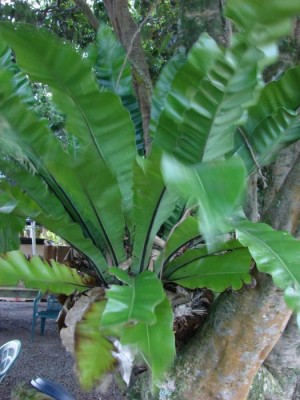Asplenium nidus : The bird’s nest fern
Commonly known as a bird’s nest fern, Asplenium nidus has many names. For instance, in Malaysia it is called: Rumah Langsuyar, in the Philippines: Pakpak-lauin and in China: Tai wan shan su hua. There are also many synonyms for this fern, which include Asplenium ficifolium, Asplenium antiquum, Neottopteris mauritiana, Neottopteris nidus. It belongs to the Plantae Kingdom , Pteridophyta phylum, Polypodiopsida class, Polypodiales order, the Aspleniaceae family, Asplenium genus.

the photo shows growing fern epiphytically on the trees. It is taken by Forest & Kim with taken permission.
Geographical distribution:
This fern is a native of tropical Africa , Australia and tropical Asia. Asplenium nidus either grow terrestrially on the ground, or epiphytically on the trees. Sometimes they grow on rocks (Piggott, 1988).
Fern description:
The sword-shaped fronds grow from the centre of the plant to form an inverted cone. The fronds are very long approximately 50-120cm, and 10-20cm wide, also the leaves or fronds are light green, often crinkled, with a smooth-edged blade and a black midrib that is obvious. The sporangia develop in clusters called sori, covered by an elongated indusium on the back of the fronds. It has roots for absorption of water and minerals from the soil (Koh, 2009). In terms of size this alters according to the habitat (Piggott, 1988).
Growing conditions:
Soil : Rich organic compost, and peat moss based.
Water: The fern needs soil moisture and a high level of humidity, but the fronds become yellow if the roots are too wet.
Light: This fern does not like direct sun, because of growing inside forests where it is shaded by high trees that do not allow the sun touch the fern directly.
Temperature: 60-75F/ 16-24C.
Fertilizer: due to slow growth the bird’s nest fern does not need much fertilization. A monthly application of balanced NPK liquid fertilizer to the soil surrounding the plant can be beneficial.
Uses :
1- people can use this fern as ornamental plant in their houses. but it needs intensive care.
2 – medicinal use : a lotion can be extracted from the leaves which is used to treat fever, or uses infusion of leaves to treat labour pain. also a decoction is used to ease labour in childbirth. In addition, the young fronds can be used to make tea taken in the morning to relieve general weakness.(Koh, 2009).
References:
Piggott, A. G. (1988). Ferns of Malaysia in colour (Vol. 1087365704). Kuala Lumpur: Tropical Press SDN. BHD. xi, 458p.-col. illus.. ISBN.
Koh, H. L. (2009). A Guide to Medicinal Plants: An Illustrated
Scientific and Medicinal Approach.
National Tropical Botanical Garden. (2013). Meet the plants. Retrieved October 28,2013, from http://www.ntbg.org/plants/plant_details.php?plantid=1304
Daves Garden. (2013). PlantFiles: Bird’s Nest Fern, Crow’s Nest Fern Asplenium nidus. Retrieved November 2, 2013 from http://davesgarden.com/guides/pf/go/54387/
* The first and second photo is taken by permission from Forest & Kim by Email.
Salah is a MSc student at the University of Reading, I am interested in describing plants morphologically and anatomically.




Hi Salah, this is the first time I’ve seen the synonyms in the genus Nettopteris. Which reference are they from?
Thanks for the response. So the correct synonym is Neottopteris.